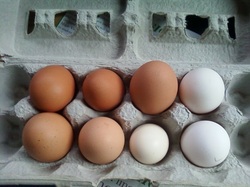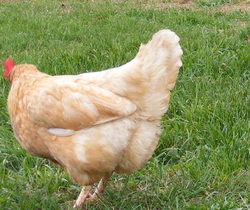 Besides the horses, laying hens were our first foray into livestock. They are for lots of people. Hens have a relatively low investment cost (you can order chicks from a hatchery for about $2 each), require only moderate housing, a daily does of grain and all of your leftovers, and in 5 months you’ll get about an egg a day from each girl. Their production peaks when the days are the longest and wanes as the winter comes and we have less daylight. So eating seasonally for eggs, means eating plenty in the spring and early summer and cherishing every egg in the winter. Production will slow down again after they are about 2 years old, which is why in commercial operations they are culled at that age. They are great backyard livestock that are accessible to almost anyone anywhere and are very affordable when a family is raising a small flock on their own property. When we started scaling up to sell our eggs (and it became a business enterprise and not just for our own nutrition and entertainment), there wasn’t much to our pricing strategy. We marked them up just a bit more than the ones you find in the grocery store, figuring how we keep them (freedom, sunshine, fresh air) and their added nutritional value was worth the extra few cents. But lately we’ve been taking a hard look at all the enterprises on the farm and have decided that it doesn’t do anyone any good for us not to be making money on any one of our farm enterprises. If we’re not profitable, we’re not going to be able to stay here. And another family farm will be gone. So a jump from $3.50 to $5 per dozen seems like a big price increase. But here’s why we need to do it. 1. At $3.50 per dozen we really weren’t being honest with ourselves or our customers about all of our costs and labor plus profit to keep our farm going for the future. 2. They eat a lot! If you have any more than a handful of chickens, then pasture and kitchen scraps will not be enough. If you want a steady stream of eggs, you’ll have to pump some grain into them. And the price of grain has gone up about 25% in the past year. 3. Compared to other sources of protein, eggs can been seen as a great financial deal in terms of weight: One dozen eggs weighs in at over a pound of protein (not including the shell), while our beef and pork starts at $6.00/lb. So at $5.00, eggs are a great value! Check out this link http://cuesa.org/article/pastured-eggs-what-it-really-takes to get perspective from some other farms.
1 Comment
 I have a secret to share about the grocery store. Me, I like a banana with a few spots on it. I look at those green ones on the grocery store shelves and can just feel the chalkiness in my mouth. That’s why my favorite spot in the grocery store is usually in a back corner, maybe over by the bathrooms, where there is a rack of “old” produce. That’s what the grocery workers call it. I call it “ripe” produce. I’m afraid that we have become so accustomed to wanting something to LOOK perfect, that we have forgotten that looks often don’t mean much when you start talking about taste. In the US, we are wasting about ½ of the food that we grow. And grocery stores are a big part of that. Anything that doesn’t look like the perfect picture of itself gets dumped out the back door (literally). Is it the grocery store’s fault? They want to put out their “best” stuff. Trouble is, we customers equate “looking good” with “GOOD”, and so we continue to shun apples for small bruises, bananas with brown spots, and avocados for being soft. Now, we can’t just jump on the blame bandwagon at the grocery store until we take a hard look at what goes in our garbage. At home we throw away an enormous amount of good food as well. Even from the beginning, some food will be wasted because it can’t get harvested, or just isn’t right for consumers. Check out this TED talk to see more about what I’m talking about. On the farm, we feed uneaten food to chickens, pigs, or throw it in our compost pile. Not much gets wasted around here. Even our tomato and pumpkin plants get thrown in the pig pen after we’re finished harvesting. This type of recycling was common in leaner times in history. During WWII, people in England kept metal “Pig Bins” on street corners to save food that people weren’t going to eat for the pigs. These days, feeding pigs such leftovers is illegal, but is there something more we can do to recycle our food? It seems to me that shopping from that rack of old produce is a start. Tell the grocery store you don’t need perfect food. Ask your local grocer to compost what they throw away, or give the blemished produce to a pig farmer. Take care in your meal preparation and encourage your family not to waste food. Make friends with a local farmer and bring some veggie leftovers over to their chickens every once in a while. A big part of raising food sustainably is not throwing away half of it. |
AuthorA blog about farming and food. Kate Bogli owns and operates Maple View Farm, raising livestock and growing veggies, with her husband Jason. The farm has been in his family for 65 years. Archives
October 2021
Categories
All
|
 RSS Feed
RSS Feed